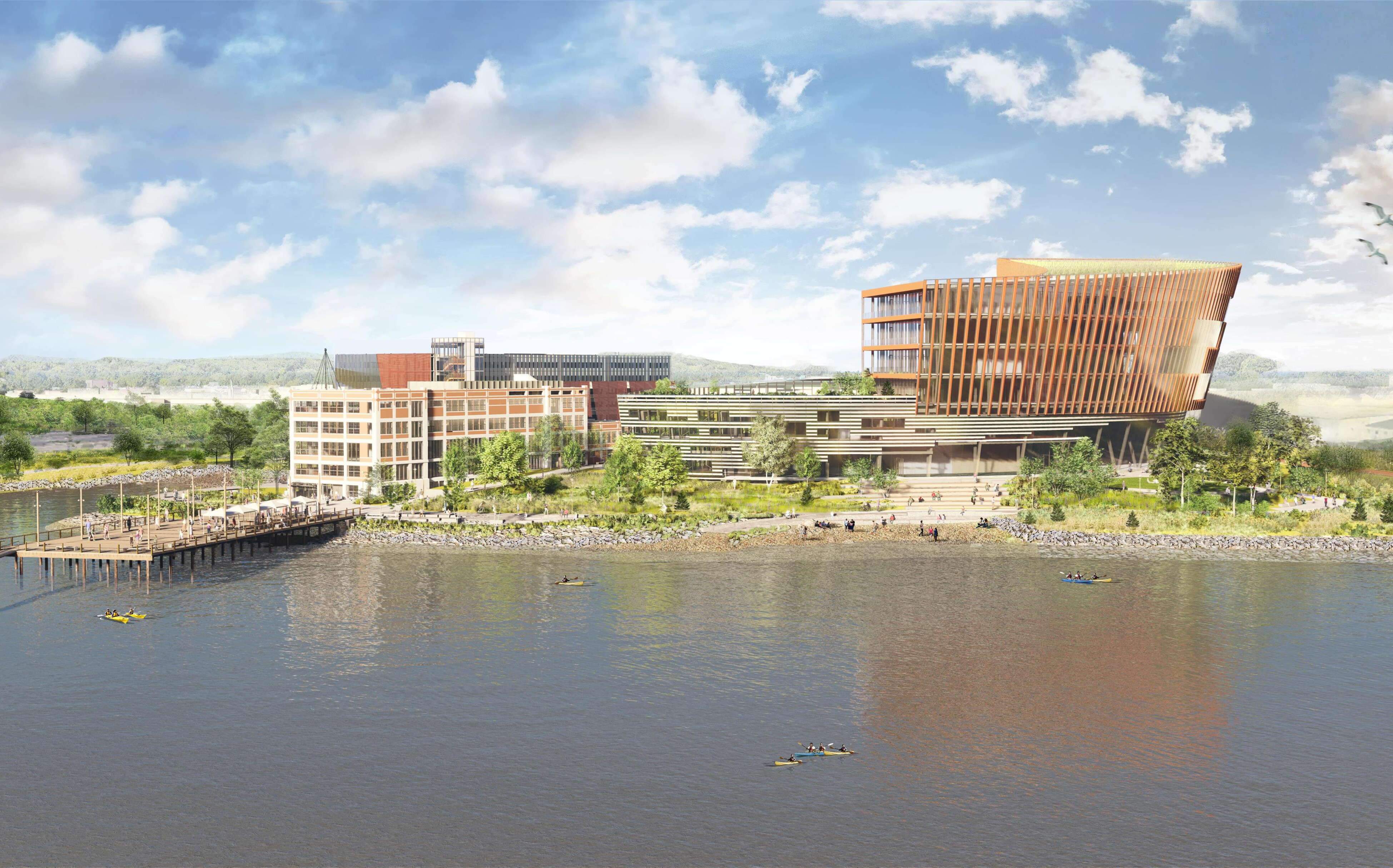
Processing Your Payment
Please do not leave this page until complete. This can take a few moments.
Turning the tide: How climate change is reshaping waterfront development in Maine
 Photo / Tim Greenway
Casey Prentice, developer of the Portland Foreside mixed-use neighborhood on the city’s East End, says that floating docks at the Fore Points Marina help cushion the impact of ocean waves.
Photo / Tim Greenway
Casey Prentice, developer of the Portland Foreside mixed-use neighborhood on the city’s East End, says that floating docks at the Fore Points Marina help cushion the impact of ocean waves.
As Casey Prentice transforms 10 acres of formerly industrial land into a mixed-use neighborhood along Portland’s eastern waterfront, increasingly volatile weather is top of mind.
Portland Foreside, which represents an investment of close to $1 billion, is anchored by the Fore Points Marina, a 150-slip, deep-water harbor with berths for 12 super-yachts. The $27 million marina includes large concrete blocks designed by Sweden’s SF Marina to cushion the impact of ocean waves and interior docks by Montreal-based Structure Marine Amarco Inc.
“Those docks float nine feet below the surface — they are like giant icebergs,” Prentice says. “As a result, our marina, which took a direct hit from this last storm, didn’t sustain any damage, nor did any of the vessels in the marina.”
He was talking days after the second of two January storms that coincided with astronomical high tides, causing widespread flooding that destroyed homes, boats and businesses. In Portland alone, city officials expect the damage to be around $10 million, for which they will seek reimbursement from the Federal Emergency Management Association though the agency will only cover the costs of restoring things back to what they were pre-storm, according to city spokeswoman Jessica Grondin.
The two January rain, snow and wind storms followed the Dec. 18 “Grinch” washout that caused an estimated $20 million in damage, mainly in central and western Maine.
What increasingly severe and more frequent weather events mean for waterfront development statewide: “This is an important wake-up call for the future of coastal Maine,” says Cameron Wake, a climate change expert at the University of New England. “We cannot build back the same way and expect anything different in the future.”
Building ‘for the next 100 years’
From Maine’s coast to inland rivers, private developers and others are building with an eye to a stormier future. They see it not just as a challenge, but also an opportunity to innovate.
“When we build something, it’s for the next 100 years, not for the next 20, so seawalls and breakwater have to be included in any plan we do,” says Drew Lyman, president of Lyman-Morse Boatbuilding Inc. in Thomason and Camden who led the $15 million remake of the Camden waterfront. While Lyman finds that local zoning limits on building height remain an obstacle, he hopes the storm aftermath will shift the dialog from the political to the practical.
“If we don’t have reasonable conversations now,” he says, “nothing’s going to happen, and that’s my biggest fear.”
Along similar lines, Prentice points to a moral obligation for responsible development.
“The built environment defines the places we live, and that can be both positive and negative. We build places where people live, work, start businesses, engage socially and literally live their lives,” he says.
To develop projects that are both financially and environmentally sustainable, Prentice says he looks at steps including moving electrical and other heavy equipment to rooftops.
Fathom Cos. President Jim Brady, the developer behind Portland’s Press Hotel and Canopy by Hilton, also sees hurdles — and costs — associated with building higher foundations.
“The waterfront is still a highly desirable location,” he says, “but it’s going to cost more from an infrastructure and developer side to raise buildings,” he says. While Brady would have preferred to raise the Canopy by another foot, zoning rules at the time of construction prevented him from doing so. “We’ve had flooding issues at the Canopy, but more so from the backup of the sewer system rather than water infiltrating the doors from serious rainfall.”
He’s well-versed in building on low-lying land, having developed two Starwood Hotels along the canals of Venice, Italy, where he installed water infiltration technologies in underground trenches.
“The lowest level was virtually a bathtub at acqua alta,” the city’s notorious high tide.
As for Portland, “I don’t think we’re going to become another Venice,” Brady says. “We’ve got much bigger issues in other areas of the state.”
Two riverfront cities
In Augusta where the Dec. 18 storm pushed flooding to the highest level since 1987, the city is seeking to raise the level of Front Street along the Kennebec River and a parking area by an average of four feet above the current floodway via a $4 million project that’s awaiting the green light for federal funding.
The aim is to reduce the frequency of closures caused by flooding from once a year to once every two to three years. Adding a pedestrian deck on Water Street and improving downtown sidewalks and pedestrian amenities are also under consideration, though extreme weather events would still require closing Front Street and adjacent lots since the area above the historic high-water mark would not be raised.

“This winter has highlighted the challenges of climate change, especially for those of us living or working near rivers or the ocean,” says Keith Luke, the city’s economic director. “Riverfront communities are part of the fabric of American life.”
As for future input from the private sector, Luke says, “It’s not easy to find developers who can self-finance projects in the floodplain, but increasingly, that is what we need to do.”

About 30 miles away in Auburn, the city has acquired lands along the Androscoggin River — where December’s storm triggered catastrophic flooding — for open space and trails to provide a buffer and is working with FEMA on updating flood maps to reflect changing storm patterns.
“This has not been done since the ‘70s in such a comprehensive way and will take into account new statistics on recent rainfall and flooding events,” says Eric Cousens, the city’s director of planning and permitting.
Auburn also works with private developers “to help design projects that take advantage of the waterfront views while protecting our community and their investment,” says Jay Brenchick, Auburn’s economic development director. One example is a project underway at 1 Center St. to extend the land available for the riverwalk while meeting or exceeding FEMA standards.
From Casco Bay to the Atlantic Coast
Climate change-focused innovation isn’t limited to traditional developers.
In Portland, the Gulf of Maine Research Institute owns two wharves, including Union Wharf which the nonprofit bought in 2021. It’s made $75,000 in improvements since then, including installing elevated heat pumps at 36 Union for $36,000 and replacing an oil boiler at 41 Union with a wall-mounted propane unit at a higher location.
“Union Wharf represented a unique need and opportunity to support a critical piece of Portland’s working waterfront,” says Jonathan Labaree, GMRI’s chief community officer. “We don’t have plans to purchase additional wharves, but plan to use Union Wharf as a platform to guide others – public and private – in how to protect, manage and maintain working waterfront across the region.”
Elsewhere in Portland, the future campus of Northeastern University's Roux Institute will be built on the former B&M baked bean factory site with a basement elevation of nine feet, says Chuck Hewett, executive director of IDEALS, the nonprofit behind the $500 million plan to build a campus by 2027.
“It’s been flooded three times in the last 24 years with a few inches of water,” he says. Nevertheless, to be on the safe side, he says the group plans to raise that floor to 11 feet and construct all buildings with a ground floor elevation of 22.5 feet.
“That’s very high and dry and should be secure for the long term,” he says.

And in coastal Biddeford, the University of New England will use nearly $140,000 in grant funding to mitigate coastal erosion and restore parts of the shoreline on its campus that researchers say have been marred by the effects of climate change.
“The issue of sea level rise is not purely academic for us,” says climate expert Wake.

















0 Comments